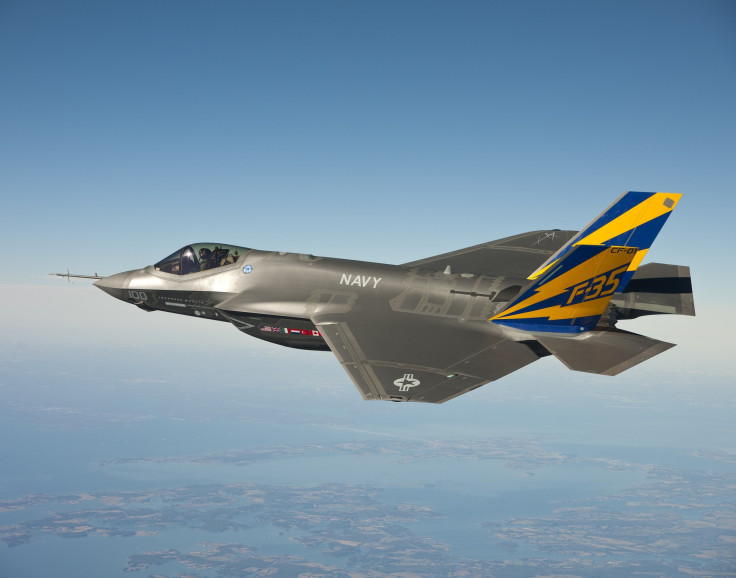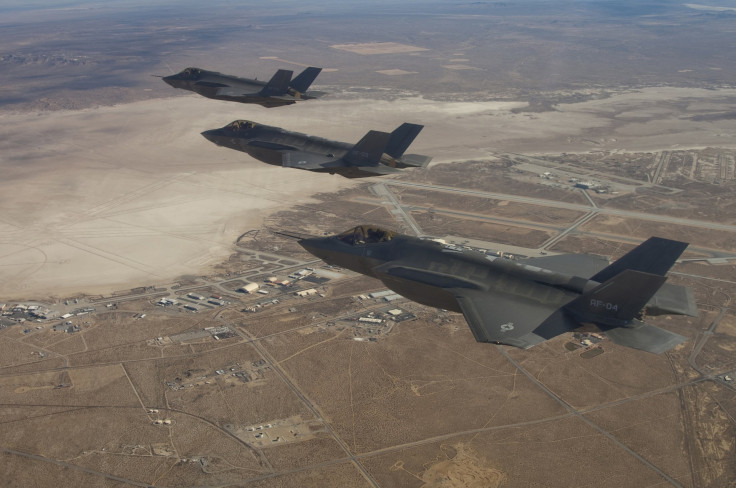F-35 Joint Strike Fighter Jet Will Sling Lethal, Unmanned Drones At Enemy Targets -- It Just Has To Get Off The Ground

Almost since the day it was conceived, the F-35 Joint Strike Fighter has been a disaster. Production of what was supposed to be the ultimate fighter jet for the U.S. Air Force, Marines and Navy has consistently blown deadlines and its costs have ballooned to $163 billion over budget.
Even worse, it all could have been avoided.
The U.S. Air Force and contractor Lockheed Martin say they’re (finally) putting the finishing touches on the F-35 Joint Strike Fighter, a trillion-dollar war machine that was supposed to be ready for battle nearly 10 years ago.
But problems persist. The latest: Congress is furious that pilots who weigh less than 136 pounds -- which could include many women -- are prohibited from flying the aircraft because of an increased risk of injury upon ejection. Before that, Newsweek reported, the Pentagon official in charge of operational testing said Marine Commandant General Michael Dunsford was wrong when he declared the F-35 combat-ready in July.
That’s not to mention the leaked report from a test pilot complaining that, for all the F-35’s supposed perks, it still lost a dogfight against the much older F-16. Oh, and Chinese hackers stole sensitive radar designs and engine blueprints and seemed to use them for their own jets.
The series of high-profile whiffs, combined with the still-growing cost and increased drone capabilities, has led to a wave of speculation that the F-35 will be the last manned fighter ever produced for the U.S. military, and maybe it will be.
It’s loaded with over 8 million lines of computer code (compared to 2.2 million in the F-22 Raptor) meant to adjust for software updates that roll out over the jet’s anticipated 55 year lifespan. F-35 pilots will almost certainly control a fleet of drones from their cockpit, and the $400,000 helmet will make them seem more like missile-packing cyborgs.
It just needs to survive the next decade first.
Retired Maj. Gen. Jay Lindell, a former director of Global Powers Programs at the Office of the Assistant Secretary of the Air Force for Acquisition, said the F-35’s problems began at inception, when it was classified under the Joint Strike program. Rather than putting up the big bucks for a plane for each military service, the Department of Defense sought to save American tax dollars by building a single aircraft with slight customizations for the Marines, the Air Force and the Navy. IBT caught up with Lindell to get his thoughts on the program's future.
International Business Times: Is the F-35 ever going to be ready? What went wrong here?
Jay Lindell: The initial program was made in October 2001 to produce the F-35, and here we are 14 years later without the Air Force declaring initial operation capability, and that’s still one year out or so.
The smart thinkers at the time decided that the idea of a joint aircraft for all services would save money. There were some, and I can tell you there were some within the Air Force, who thought “No way. The history of joint strike programs has never been very successful.” You can look at the days of joint fighter programs, like the F-111, and they didn’t necessarily work out. But this was driven top down to be a joint program.
For example the Marines' model has vertical takeoff and vertical landing requirements. Because of that, the weapons had to be modified specifically to be able to handle heat in the weapons bay. Then to operate off ships, we had to go back in with engineering changes for structures to enable ship rescues.
They may look the same, in as far as each model is a winged aircraft, but when you start getting into the guts of it, and the way things need to be modified for each operation, they’re very different aircraft. And all that drives cost.

IBT: How much is it actually going to cost? The military’s most recent order was for a total fleet of 2,457 F-35s. We’re talking about a lot of planes.
Lindell: The projected cost is coming down slower than planned, but as the Air Force is approaching its Initial Operational Capability decision, the cost is approaching $100 million per plane. It was targeted to get to $85 million, but I think they’re going to have to settle on around $100 million. And that’s just the flyaway production cost; that’s not including all the other costs like R&D and facility infrastructure that will go into the program.
I think it’ll be ready next year. It may not be the final software that they want for full operational capability, but that’s normal when you’re talking about advanced aircraft. It will be continually updatedwith software. Some modifications will take place on the flight-line, where they’ll take a couple hours, and some are more complex and may have to fly away for technical service.
IBT: What’s the military going to get for all that money? Now there’s growing concern about fatal ejections, and don’t forget the leaked memo from a test pilot saying the F-35 lost a dogfight to the F-16.
Lindell: I’m not privy to all the classifieds, but in the long run it will prove to be a very capable platform. It’s not designed to be a dogfighter like the F-16 was. It was designed to be high-tech and to fight future wars. Can it defend itself in combat? Yeah. Was it designed to be as maneuverable as the F-16? No. But it has all the advanced avionics and is integrated to include the latest weapons. It will be just fine.
Air Force philosophy is you’ll never have a fighter without a gun on board. The F-35 has a 25 millimeter cannon. Fighters today have a 20 millimeter, and this is a slower rate of fire, but greater range and greater lethality. With precision avionics and the ability to shoot at longer ranges, it’s a significant capability for the aircraft. It’s a leap forward in the right direction because previous planes used more of a spray pattern. Today, once this is fully integrated into the sights into the helmet, it will be significantly more lethal.
Dogfighting is a basic skill, and it’s still a skill you train for because as proven many times over, as much technical capabilities as there are in any given battle, you just never know what kind of gun is going to come through the fog of war.
IBT: With this pricetag, and with price of drones plummeting, is this the last manned fighter we'll ever see from the military?
Lindell: Whenever you start talking about maybe a trillion-dollar weapon system, that's a tough pill to swallow. An integrated type of deployment is the next step, and the next step after that is probably totally unmanned aircraft. I think it will be a mixed deployment force. There might be unmanned aircraft who are essentially the targets and then a manned fighter that sends the missiles.
© Copyright IBTimes 2024. All rights reserved.











